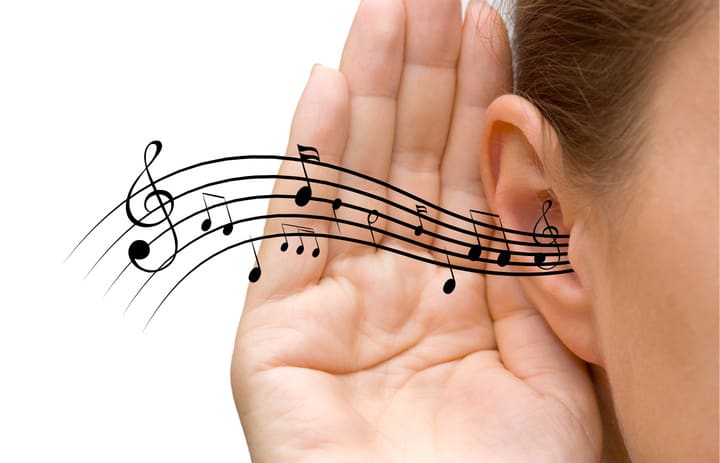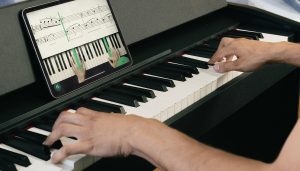Ear training is the art of honing one’s ability to recognize chuches, intervals, melodies, and chords solely by ear. It’s like developing a sixth sense for music, allowing pianists to play not just with their fingers but with their ears as well. Through a series of carefully crafted exercises, piano ear training opens doors to musical fluency, improvisation, and a deeper understanding of the language of music. So, let’s embark on this journey of discovery and refinement, as we delve into the realm of piano ear training together.
Ear training exercises
There are many apps and websites you can find for ear training skills. We are using exercises from MusicTheory.net. They are simple and effective to use.
Pitch recognition exercises
The ability to recognize various pitches is a foundational element to ear training. There are two types of pitch recognition abilities: absolute pitch and relative pitch. It is generally agreed that absolute pitch is a skill that is acquired between 0 and 2 years of age. So, if you are not among those people who somehow managed to acquire absolute pitch, you have the fantastic opportunity to master relative pitch!
Note ear training
Relative pitch is the ability to hear and identify notes in relation to one another. Basically, if you know the pitch of one note, you can hear another note and identify it. It is helpful to have a basic understanding of intervals, as well as the knowledge of all 12 notes in our music system.
This relative pitch training tool gives you a reference pitch and then plays another note after. Your job is to identify the second note based on the first note. This is the essence of relative pitch training.
Interval ear training
Piano ear training with intervals is another fundamental practice that should go hand in hand with relative pitch training. Learning how to hear and identify intervals like major and minor thirds or major and minor sixths is a huge advantage. Plus, those intervals form the basis of most of our triads and extended chords. So, if you want to be able to hear chords down the road, you will need to be able to intervals first.
Practice identifying intervals in isolation to get a good grasp of how basic intervals sound. Once you feel good with that and can manage a high score, try identifying intervals in context.
This interval training tool plays intervals melodically, meaning one after another. Give it a shot and see how well you do!
Chord and chord progression
Once you have a solid grip on interval training and are developing your relative pitch skills, the next step is to spend some time learning to identify chords and chord progressions by ear. Learning to hear chords and common chord patterns will open many doors for you and help your understanding of music immensely.
This chord identification tool features a range of different chords, from triads to more advanced seventh chords. Can you hear the difference between a major triad and a major seventh chord?
Scale ear training
Another key element in piano ear training is learning to identify scales. While slightly more advanced than hearing intervals and piano chords, learning to identify different scales is equally helpful to advancing your piano skills.
This scale training tool plays scales one note at a time in ascending order. The difference between some scales is subtle. But, the difference between the major scale and the harmonic minor scale is huge! Over time, you will develop the ability to distinguish these sounds quite quickly.
Interactive ear training quiz for beginners and pros
Once you have practiced with all the exercises, try taking the quizzes at Toned Ear to test your progress.
Interval quiz
The test is designed to assess the understanding of musical intervals, the distance between two notes. It challenges participants to identify or create specific intervals, enhancing their musical ear and theory knowledge.
Interactive chord identification quiz
is a focused exercise aimed at testing and improving one’s ability to recognize and name different chords. This quiz challenges individuals to identify various chord types and qualities by sound, enhancing their musical ear and theory knowledge.
Test your knowledge with interactive music scales quiz
The quiz is designed to evaluate and enhance one’s knowledge of musical scales. It involves identifying different types of scales, such as major, minor, and modal, either by their visual representation on a staff or by listening to their auditory sequence.
Chord progressions quiz: enhance your musical understanding
This is an educational tool aimed at testing and enhancing one’s understanding of chord sequences in music. Participants are challenged to identify or construct various chord progressions, recognizing their patterns and how they contribute to the harmony of a piece.
Perfect pitch quiz: discover your musical ear potential
This is a specialized test designed to determine whether an individual possesses perfect pitch, also known as absolute pitch. This quiz typically involves identifying specific notes or chords played without any reference tone.
Scale degree quiz: explore your musical theory skills
It is an educational exercise focused on testing and improving one’s knowledge of scale degrees within various musical scales. This quiz challenges individuals to identify or name the specific degrees of scales (like tonic, mediant, dominant, etc.) in both major and minor keys.
What is ear training?
Ear training, or aural skills, is the practice of learning to identify pitches, rhythms, chords, and other music theory concepts by ear. Practicing ear training exercises will increase all aspects of your musicianship. You will become a better player, develop a deeper relationship to the music you study, the music you listen to, and sounds around you in general. Additionally, other musicians will enjoy playing with you more because you will be genuinely listening to them and just hearing them.
How do I develop my ears?
Training your ears is not a terribly difficult task, but like all musical skills, takes dedication and consistent effort. There are many ways to go about developing excellent aural skills. The trick is to follow through.
Relative pitch versus absolute pitch
Have you ever met someone with perfect pitch? Perfect pitch is the ability to hear literally any sound and instantly recognize its pitch and tuning from the notes on a piano to the creak of a door, to the hum of an airplane. Most musicians do not have this ability and not all those who do ever use it for anything extraordinary.
How to develop relative pitch
The easiest way to develop relative pitch is to choose one note and memorize it. Sit relaxed at the piano and sing or hum the most comfortable and easy note for your voice. Don’t force it and don’t try to do anything in particular except make the most comfortable sound you can.
Now match this pitch on the piano. For me, this pitch is C3, the C one octave below middle C. I found I could reliably and comfortably sing this note at any time of day. It is my foundation pitch. Your pitch might be A3, middle C, or something else. The trick is to find this comfortable pitch and commit it to memory. Sing it as many times as you can every day and match yourself with the piano or with a chromatic tuner.
Expand beyond the foundation
The major scale
Once you find your foundational pitch, you can expand beyond and begin to build your internal pitch map. The first step is to learn how to sing the major scale. Don’t worry about how your voice sounds, singing is an excellent way to internalize pitches because they literally come out of your body. For more information on scales or if you need a quick review, check out this blog post from Skoove about scales.
Intervals
Once you feel comfortable singing and have internalized the sound of the major scale, you should begin to practice interval identification. Interval identification involves listening to two notes and identifying the distance between them. Remember intervals are measured in semitones or half-steps and include a quality description such as major, minor, or perfect and a numerical description like first, second, third, fourth, fifth, sixth, seventh, etc. For more information on this, check out this excellent blog post from Skoove all about intervals.
Tips for effective ear training
Developing a strong ear takes time and patience. Be patient with yourself and celebrate your progress, no matter how small. Stay persistent and keep pushing yourself to improve, and you’ll gradually see results. Remember to enjoy the process of ear training! Approach each exercise with curiosity and enthusiasm, and embrace the joy of discovering new sounds and musical connections.
Consistent practice is essential for developing your ear. Set aside dedicated time each day to work on ear training exercises. Even short practice sessions can yield significant improvements over time. Begin with simple exercises such as identifying single notes, intervals, or basic chords. Mastering these fundamental skills will provide a solid foundation for more complex ear training tasks.
Transcribing music by ear is another excellent way to develop your ear training skills. Start with simple melodies or chord progressions and gradually work your way up to more complex pieces.
Frequently asked questions on ear training
What is ear training?
Ear training is the process of developing and refining one’s ability to recognize and understand musical elements such as pitch, intervals, chords, melodies, and rhythms solely by ear.
Why is ear training important?
Ear training is important for musicians as it enhances their ability to play by ear, improvise, sight-read, transcribe music accurately, and communicate effectively with other musicians. It also deepens their understanding of music theory and fosters a more profound connection to the music they create or perform.
Can anyone improve their ear for music?
Yes, absolutely! While some individuals may have a natural inclination towards music or possess innate musical abilities, ear training is a skill that can be developed through consistent practice and dedication.
How often should I practice ear training?
The frequency of practice depends on individual goals and schedules. However, practicing ear training regularly, even for short durations each day, is more beneficial than sporadic, intense practice sessions. Consistency is key to improvement.
Is perfect pitch necessary for ear training?
No, perfect pitch is not necessary for developing strong ear training skills. While perfect pitch can be advantageous, especially in certain musical contexts, relative pitch (the ability to identify and reproduce pitches in relation to each other) is more commonly developed through ear training practice and is sufficient for most musicians.
Author of this blog post

Eddie Bond is a multi-instrumentalist performer, composer, and music instructor currently based in Seattle, Washington USA. He has performed extensively in the US, Canada, Argentina, and China, released over 40 albums, and has over a decade experience working with music students of all ages and ability levels.
Published by Lidya Hovan from the Skoove team















